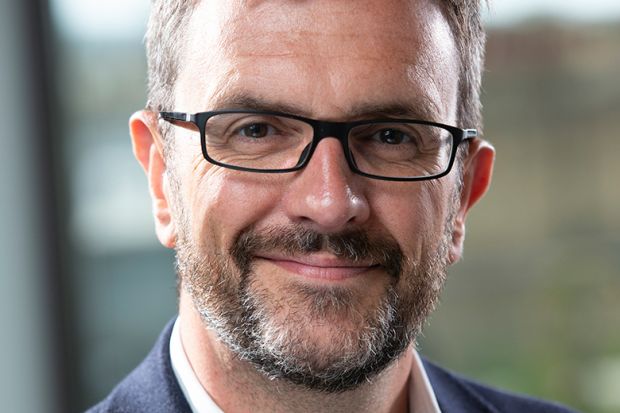Paul Howarth is CEO of the private equity-owned Times Higher Education (THE). He was appointed in March 2020 after almost four years as CEO of Law Business Research, of which he is now chair. A biology graduate from Oxford University and an MBA from the London Business School, Howarth spent 13 years at Pearson Plc (the world’s largest education business), latterly at Pearson VUE, the global electronic testing company. In 2022, THE is expected to have revenue of £35m and EBITDA of £9.6m, 65% and 80% respectively ahead of 2021, largely as a result of the acquisition of the US-based Inside Higher Education for an estimated £30-35m. THE was launched in 1971 by The Times of London which had introduced Times Education Supplement (TES) back in 1910. They were sold by Times owner News UK in 2005. THE was carved out of TES Global in 2019 and sold to Inflexion for an estimated £92m. Significantly, Times Higher Education’s primary business is no longer the eponymous twice-monthly magazine which last year celebrated its 50th anniversary. The large majority of its profit is now derived from its influential World University Rankings, first published in 2004.

What were your earliest career ambitions?
Not remotely what I’m doing now! I graduated having read Zoology and led expeditions to Venezuela, Cameroon and Namibia, finding new species and dodging very large amblypygids. Following in David Attenborough’s footsteps was appealing! A more serious career ambition was to study medicine, but I felt that you needed a lifelong ambition to succeed in that field.
In reality, my early career was somewhat serendipitous and I tried a number of things (including consultancy) until I found something that suited me better – a role at the Financial Times. My first boss there was fantastic and I felt very proud working for the FT. I also met my wife there so the benefits really were good!
What were the milestones of your career at Pearson?
I owe Pearson a lot. I worked for multiple businesses (the FT, Penguin, Pearson Education), travelled extensively and had some impressive role models as managers. Marjorie Scardino was very motivational and she navigated the first dot com boom well, and the Pearson share price mirrored that. My career highlights include all of my time at the FT, working on Penguin’s global strategy, being one of the core team that acquired Edexcel (which many senior figures at Pearson had said was impossible) and growing the Pearson VUE EMEA business significantly.
While I worked with some great people, I did learn the lesson that seniority in people does not always reflect capability.
How did Law Business Research equip you for the role at Times Higher Education?
LBR was a fantastic experience. I joined in September 2015, two years after Bowmark had invested. We had a couple of years of great growth before selling the business to Levine Leichtman in December 2017 via a competitive process. Six months after this, LLCP supported us to acquire Globe Business Publishing – a really important strategic move that brought the Lexology platform and market leadership in IP.
I learned many things that have helped me transfer successfully to THE – how to work with founders, what private equity deems success in a B2B data and insights business, creating a very high functioning senior management team and integrating acquisitions. LBR and THE are very similar in what they do, which has allowed me to be chairman of LBR while also taking on the CEO role at THE.
What’s special about THE?
Times Higher Education is a remarkable business, operating in over 200 countries and territories. It is truly international. A partner CEO once said to me that the THE name allows me to call pretty much any VC/President of a university and they will take the call – a remarkable privilege that demonstrates the strength of the brand and its reputation.
With the acquisition of Inside Higher Ed in January, we now have the largest global platform of higher education academics and work with well over 3,000 institutions. We don’t have a direct competitor and the barriers to entry are really significant. It’s our relationships with university leadership around the world that makes us unique.
University rankings are a very competitive market. How and why is THE the market leader?
The Times Higher Education World University Rankings are the most balanced and comprehensive global ranking – with 13 separate performance metrics, covering all core activities of globally-focussed and research-led universities: teaching, research; knowledge transfer; and international outlook. The other prominent rankings both have only six metrics each – and they are very narrowly focussed on research.
THE rankings are also underpinned by extremely rich data: this year over 2,500 universities from 123 countries have submitted data and we’ll rank almost 1,800 in October. Our methodology draws on an analysis of 15.5m research publications and 121m citations to those publications, and over 40,000 responses to an annual academic reputation survey. It also includes data on finances as well as demographic factors.
Times Higher Education’s rankings are one of the oldest and most established of the global rankings – founded in 2004 – but they remain the most dynamic, innovative and state-of-the-art. Our rankings were built – and they continually evolve – in direct partnership with the global academic and university leadership community, our core, original audience. This means we set the methodology from the outset with very high academic standards of rigour. We have been refining the methodology in consultation with – and under the close scrutiny of – the sector for close to 20 years. This commitment to constant innovation and improvement has also allowed us to pioneer vital new metrics to support the sector. Key among these has been the THE Impact Rankings, the world’s only university ranking system to measure a university’s social and economic impact, judged through the lens of the Sustainable Development Goals.
All these factors combine to make the THE World University Rankings the recognised “gold standard” for university performance analysis, trusted not just by students and their families choosing who to trust with their education, but by university academics to make career decisions, university leaders to set and monitor strategic targets and, increasingly, by national governments seeking to deploy the rankings’ data to help inform policy.
Is THE print magazine now just a marginal activity?
The magazine as a fortnightly print format is certainly much less central to THE’s business than in the past, but our editorial output as a whole remains crucial. It is at the heart of both our identity as a trusted source of information about higher education, and as the route to engaging large global audiences with THE as a brand.
While we do still have a loyal B2C print subscriber base, the majority of both audience and subscription revenue now flows from our online output (as you would expect). This has been driven not only by the shift from print to digital, but by THE’s change of focus from UK to international across all our product streams. The role of content in engaging the audiences we are addressing as a business has necessitated a shift in editorial strategy, and that has proved to be very successful.
As part of that, we have developed an institutional subscription model, with several hundred universities subscribing on behalf of their staff and students, and a new content platform, THE Campus, which is focused on professional best practice for a global higher education audience. This delivers peer-to-peer advice, guidance and resources in a range of ‘verticals’ based around areas of professional practice, and has enabled us to develop new B2B and sponsorship revenue streams.
What is your own primary role?
I’m a facilitator, giving my team autonomy to do what they feel is best for the business. After all, they have operated in higher education far longer than I have. I have changed the structure to allow me to focus much more on M&A. We’ve acquired two businesses to date: The Knowledge Partnership and Inside Higher Education. There are others in the works which will significantly enhance our capabilities. I enjoy the industry and the people in the business. Education attracts a very loyal, dedicated type of person and THE benefits from this. Instigating change is also fun: for a long time, we were seen as just a publisher of content and now we are a true data and insights business.
What’s your vision for THE in, say, five years?
Times Higher Education will be 51 years old this year. It has tremendous authority around the world and I’m really honoured to be part of its journey. Our strapline is “Unlocking the power of global higher education” and we do this through a combination of data, consultancy, the very best journalism, partnering with innovative businesses and hiring the best people.
The number of Higher Education establishments is estimated at approximately 20,000. We work with about 15% of the market so there is a lot of room for organic growth. Government relationships are still in their infancy but we’ve seen really exciting growth over the last couple of years and I expect this to drive significant expansion over the next five years.
What’s remarkable about higher education is how fragmented the market is, and how many businesses serve it. M&A will be a key part of THE’s growth and – combined with our organic plan – I would hope that our revenue is significantly higher than £100m by 2027.
What are the best lessons you have learned?
Look at everything. It is much better to say ‘no’ to an opportunity you’ve researched and turned down rather than wishing you’d gone after something which you’d passed over at the time. I am a strong believer in treating people how you wish to be treated yourself. The most difficult thing to get right is communication but, when it works, it is extremely powerful.
Which other companies do you most admire?
I thought long and hard about this. I have an overwhelming respect for owner/founder businesses. I’m not an entrepreneur but I have friends who are, and I am humbled by their efforts. My role now brings me into contact with many more people in this position and this has reinforced my view. The one ‘traditional’ company I admire is Patagonia (outdoor clothing). It took sustainability seriously, well before it became trendy to do so. They also make seriously good gear which appeals to me as I am a total gear head! Many others have jumped on the bandwagon but Patagonia was first.




